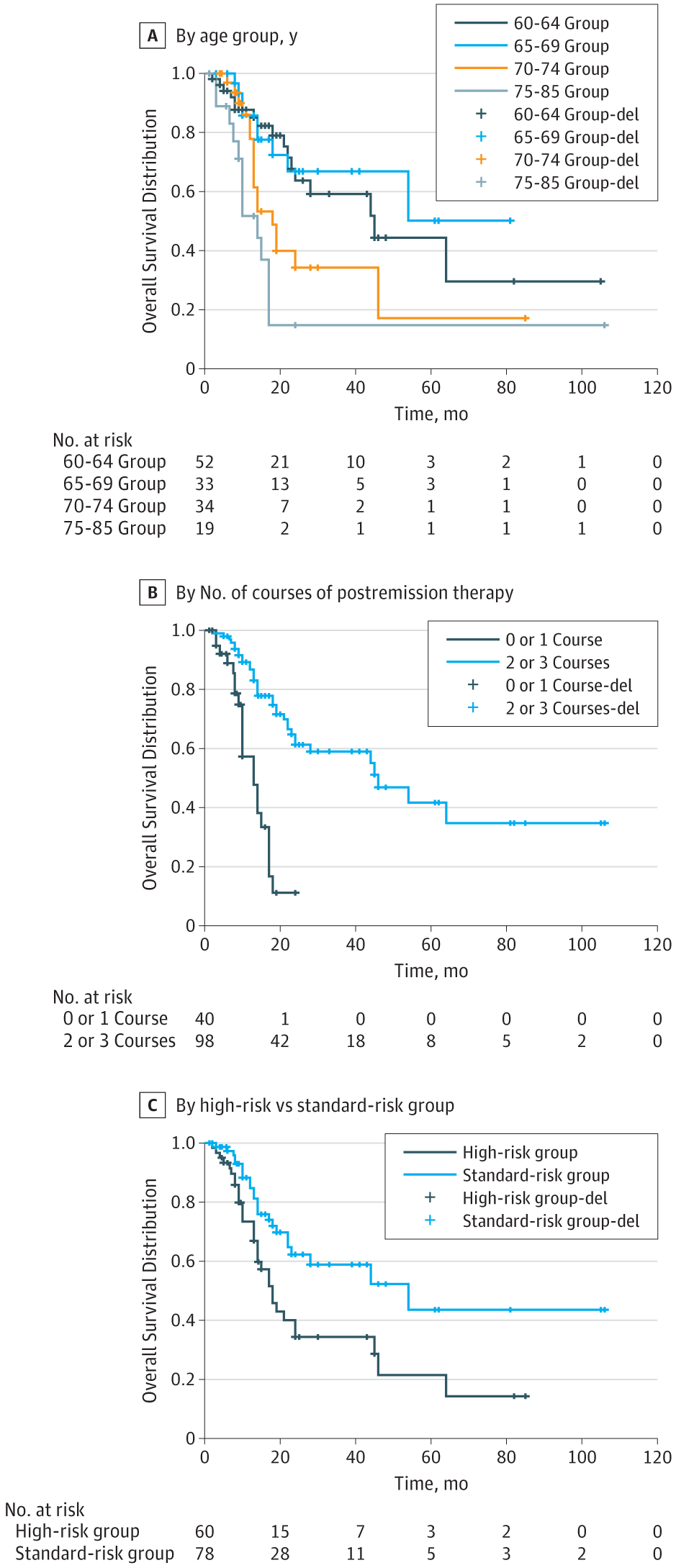JAMA Oncology ( IF 28.4 ) Pub Date : 2018-01-01 , DOI: 10.1001/jamaoncol.2017.2656 Mei Guo 1 , Nelson J Chao 2 , Jian-Yong Li 3 , David A Rizzieri 2 , Qi-Yun Sun 1 , Ann Mohrbacher 4 , Elizabeth F Krakow 5 , Wan-Jun Sun 6 , Xu-Liang Shen 7 , Xin-Rong Zhan 8 , De-Pei Wu 9 , Li Liu 10 , Juan Wang 11 , Min Zhou 12 , Lin-Hua Yang 13 , Yang-Yi Bao 14 , Zheng Dong 1 , Bo Cai 1 , Kai-Xun Hu 1 , Chang-Lin Yu 1 , Jian-Hui Qiao 1 , Hong-Li Zuo 1 , Ya-Jing Huang 1 , Anthony D Sung 2 , Jun-Xiao Qiao 6 , Zhi-Qing Liu 1 , Tie-Qiang Liu 1 , Bo Yao 1 , Hong-Xia Zhao 6 , Si-Xuan Qian 3 , Wei-Wei Liu 15 , Rafael Forés 16 , Rafael F Duarte 16 , Hui-Sheng Ai 1 ,

|
Importance The outcome of older patients with acute myeloid leukemia (AML) remains unsatisfactory. Recent studies have shown that HLA-mismatched microtransplant could improve outcomes in such patients.
Objective To evaluate outcomes in different age groups among older patients with newly diagnosed AML who receive HLA-mismatched microtransplant.
Design, Setting, and Participants This multicenter clinical study included 185 patients with de novo AML at 12 centers in China, the United States, and Spain in the Microtransplantation Interest Group. Patients were divided into the following 4 age groups: 60 to 64 years, 65 to 69 years, 70 to 74 years, and 75 to 85 years. The study period was May 1, 2006, to July 31, 2015.
Exposures Induction chemotherapy and postremission therapy with cytarabine hydrochloride with or without anthracycline, followed by highly HLA-mismatched related or fully mismatched unrelated donor cell infusion. No graft-vs-host disease prophylaxis was used.
Main Outcomes and Measures The primary end point of the study was to evaluate the complete remission rates, leukemia-free survival, and overall survival in different age groups. Additional end points of the study included hematopoietic recovery, graft-vs-host disease, relapse rate, nonrelapse mortality, and other treatment-related toxicities.
Results Among 185 patients, the median age was 67 years (range, 60-85 years), and 75 (40.5%) were female. The denominators in adjusted percentages in overall survival, leukemia-free survival, relapse, and nonrelapse mortality are not the sample proportions of observations. The overall complete remission rate was not significantly different among the 4 age groups (75.4% [52 of 69], 70.2% [33 of 47], 79.1% [34 of 43], and 73.1% [19 of 26). The 1-year overall survival rates were 87.7%, 85.8%, and 77.8% in the first 3 age groups, which were much higher than the rate in the fourth age group (51.7%) (P = .004, P = .008, and P = .04, respectively). The 2-year overall survival rates were 63.7% and 66.8% in the first 2 age groups, which were higher than the rates in the last 2 age groups (34.2% and 14.8%) (P = .02, P = .03, P < .001, and P < .001, respectively). The 1-year cumulative incidences of nonrelapse mortality were 10.2%, 0%, 3.4%, and 26.0% in the 4 age groups and 8.1% in all patients. The median times to neutrophil and platelet recovery were 12 days and 14 days after induction chemotherapy, respectively. Five patients had full or mixed donor engraftment, and 30.8% (8 of 26) of patients demonstrated donor microchimerism. Two patients (1.1%) developed severe acute graft-vs-host disease.
Conclusions and Relevance Microtransplant achieved a high complete remission rate in AML patients aged 60 to 85 years and higher 1-year overall survival in those aged 60 to 74 years.



























 京公网安备 11010802027423号
京公网安备 11010802027423号